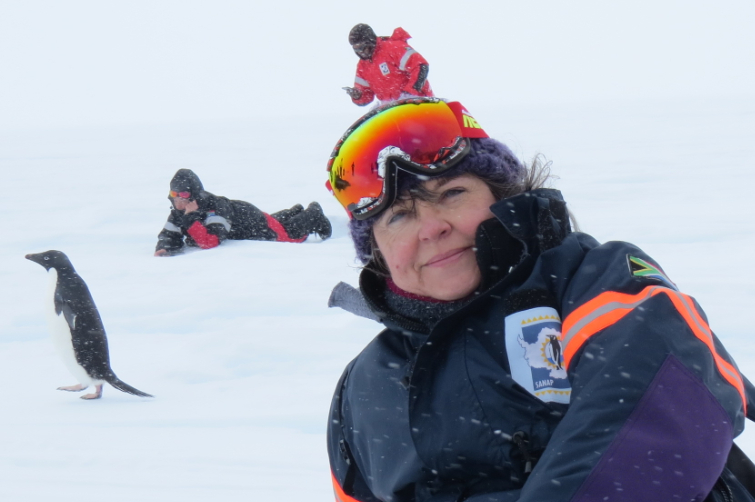31 March 2020
|
Story Leonie Bolleurs
|
Photo Gerhard de Jager
 Prof Linda Basson recently returned from a three-month research expedition in Antarctica. Here she is, relaxing on the ice with the ever-inquisitive Adelie penguins having a gander at these strangers in their snowy world.
Prof Linda Basson recently returned from a three-month research expedition in Antarctica. Here she is, relaxing on the ice with the ever-inquisitive Adelie penguins having a gander at these strangers in their snowy world.
Very little is known about the parasites of Antarctica, which is a highly productive part of the oceans. These small organisms can be used very successfully to determine the health of this fragile ecosystem.
“Our research data can make significant contributions to the biodiversity of parasites, for a start. The data can also be very valuable to indicate the overall health of this large ecosystem – an ecosystem that drives many of the life-giving processes on our planet.” This is the belief of
Prof Linda Basson from the
Department of Zoology and Entomology at the University of the Free State (UFS).
She is an aquatic parasitologist who concentrates on various parasites from a wide range of hosts, including vertebrates (fish and amphibians) and invertebrates (plankton, urchins, starfish, sea cucumbers and red-bait).
Prof Basson, together with PhD student Gerhard de Jager, was invited by Prof Isabelle Ansorge, Head of the School of Oceanography, University of Cape Town, to join her research team on the
South African National Antarctic Programme (SANAE) Voyage 59 to Antarctica.
Widen the scope of research “Our aim on this trip was to determine how we can collaborate with the various oceanographers to widen the scope of research normally performed on these voyages, in order to also include parasitological aspects. Once we arrived on the continent of Antarctica, we worked to collect a range of hosts from the Southern Ocean to screen these for the whole array of parasites,” she explains.
No research of any kind on aquatic parasites has ever been done in Penguin Bukta and Akta Bukta, the specific areas where Prof Basson was based with other scientists and the rest of the Agulhas crew.
She adds: “Our research will contribute to the wider knowledge of parasites in marine environments, but specifically in this area where little to nothing is known.”
A chance of a lifetime “Antarctica was literally one of the top research destinations on my bucket list. Travelling to and working in Antarctica is a lifelong dream of mine. It was a chance of a lifetime that I could not miss out on,” says Prof Basson.
Sharing her experience, she says a typical day on board the SA Agulhas II in Antarctica will start with a cup of good, quality coffee and a look at the prevailing weather on the stern of the ship.
“One would always be amazed by the beautiful, ceaselessly changing water, the restless sea ice and the impressive ancient ice shelf in very invigorating temperatures, while an ethereal Snow Petrel swirls past and the occasional Adelie penguin comes to gaze and contemplate the presence of this large red structure floating in their habitat and obscuring their view. After tearing yourself away from this, the rest of the day would be spent either in the well-equipped laboratory working through collected samples, or else planning the next exciting collection in the intensely cold water.”
Remarkable journey To eternalise memories of this unique experience of almost three months, Prof Basson says that, “One cannot go without a fully charged camera with a large SD card, ready to capture the many facets of this exceedingly fragile but enchanting world of ice and sky, ever changing and all in innumerable shades of white”.
“This truly remarkable journey will forever be associated with a myriad of brilliant highlights.”
Finding it extremely difficult to single out a specific highlight, she listed a long list of memorable events, but as a scientist she will always remember “realising the wealth and cornucopia of microscopic life present in the southernmost of our oceans and seeing this first-hand under the microscope”.